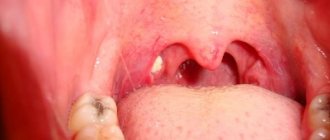06.08.2021
If we talk about the most common reasons for visiting an otolaryngologist, diseases of the throat and larynx are, perhaps, only superior to a runny nose. In most cases, patients struggle with unpleasant symptoms on their own, which often leads to complications and chronic forms of pathologies.
There are many causes of throat and larynx diseases. The lion's share of them are the consequences of the activity of bacteria and viruses, which have similar symptoms to fungal and tumor diseases. There are throat diseases without elevated body temperature; their appearance is provoked by allergens, dry air and substances that irritate the mucous membrane.
Signs and causes
Most diseases of the throat and larynx are infectious in nature. The causative agents are bacteria, viruses and fungi.
The most common bacterial
throat disease - sore throat. Its appearance is caused by streptococci, chlamydia, mycoplasmas, gonococci and tubercle bacilli. Scarlet fever, diphtheria and epiglottitis are also caused by bacteria. All three diseases are manifested by a sore throat, and epiglottitis is generally life-threatening as it can lead to airway obstruction.
Symptoms of bacterial diseases:
- general weakness;
- swelling of the larynx, tonsils;
- high body temperature;
- pain and discomfort in the throat.
For viral
diseases, a sore throat can be one of the symptoms of an illness, for example, ARVI, influenza or measles. Infectious mononucleosis caused by the Epstein-Barr virus (herpes type IV) stands apart. Its development is dangerous due to the rapid spread of inflammation to the spleen and liver, which in turn leads to enlargement of the lymph nodes.
Viral diseases are similar in symptoms:
- heat;
- prostration;
- headache;
- general weakness;
- runny nose;
- cough;
- rash;
- pain and sore throat.
Fungal diseases
genesis - a consequence of the active activity of yeast-like fungi, which looks like a cheesy mass on the mucous membrane during tonsillitis or pharyngitis. Symptoms of a fungal infection of the throat:
- severe sore throat;
- the temperature remains normal.
Fungi quickly multiply in the body during disorders of the gastrointestinal tract, against the background of vitamin deficiency, abuse of antibiotics and hormonal drugs.
A special place as a cause of pain in the throat and larynx is occupied by tumors. It can be primary, that is, formed for the first time, or it can be secondary, the result of metastasis of oncological processes in other parts and organs of the body. The larger the tumor, the more discomfort it brings: the voice changes, becoming hoarse, a feeling of a lump appears in the throat, and it becomes difficult to swallow.
Laryngeal cancer
In the classification of oncological formations, laryngeal cancer is classified as head and neck cancer, because have much in common in symptoms and consequences for the body, treatment methods, methods of recovery and rehabilitation.
Causes and risk factors.
Any cancer develops as a result of changes in initially normal cells. Abnormalities in DNA cause cells to grow and divide very quickly, leading to the formation of a tumor.
It has not yet been possible to determine the exact reason for this. However, some factors are known to increase the risk of developing head and neck tumors.
First of all, these include smoking and alcohol abuse. If a person smokes, then the likelihood of developing cancer of the larynx, pharynx, floor of the mouth, etc. higher than that of a non-smoker. Heredity matters: the presence of the disease in close blood relatives (parents, brothers, sisters or children) increases the risk of developing head and neck tumors by 2 times.
Some diseases can also provoke the occurrence of a tumor, especially viral-infectious ones - damage by the human papilloma virus, herpes, which occur in the form of chronic inflammatory diseases such as laryngitis, tracheitis, pharyngitis.
Contact with carcinogenic factors is important, as well as work in hazardous industries (long-term contact with asbestos, coal and wood dust, nickel, sulfuric acid, formaldehyde and isopropyl alcohol, radioactive substances).
Malignant tumors of the larynx account for up to 60% of all cases of cancer of the head and neck and are most often found in men, predominantly over 40 years of age.
The larynx is part of the upper respiratory tract through which air enters the lungs. It is in the larynx that the glottis and vocal cords are located, thanks to which we speak. The larynx has several main functions: respiratory, protective, voice-forming, and separating.
Symptoms of laryngeal cancer:
- voice change is one of the first signs of cancer of the middle part of the larynx;
— hoarseness or hoarseness is permanent (the voice does not improve) and is usually not accompanied by any colds;
- difficulty or pain when swallowing, complaints of a foreign body in the throat, and these symptoms gradually increase (such signs are characteristic of cancer of the upper larynx);
- shortness of breath on exertion and difficulty breathing (typical for tumors of the lower part of the larynx or for a common process).
Patients may also notice pain, sometimes radiating to the ear or leading to refusal to eat, swelling of the neck on one side or both, coughing, in some cases paroxysmal, with a small amount of mucous sputum or streaks of blood in the discharge. Deterioration in well-being may be due to increased fatigue, headaches, sleep disturbances, and exhaustion.
It is very important to see an ENT doctor when the very first symptoms appear. You should not postpone an examination by a specialist if hoarseness lasts more than three weeks, if shortness of breath does not go away or if breathing is difficult, if swallowing is impaired.
Treatment of laryngeal cancer.
Many types of surgeries have been developed to treat head and neck cancer. There are radical operations in which organs (for example, the larynx) are completely removed. If possible, doctors try to perform organ-saving surgery. In these cases, it is much easier to restore the affected functions (speech, chewing, swallowing).
If the tumor is located in the larynx or adjacent tissues, it may be necessary to remove the entire larynx or part of it (either a complete laryngectomy or a partial laryngectomy). This operation affects speech formation.
Often, after surgery in the mouth and neck area, the patient cannot breathe on his own. Then a tracheostomy is performed - a hole is made in the trachea, which becomes an alternative route for air to enter the lungs. A special tube is installed into this hole - a cannula, a tracheotomy tube. A tracheostomy allows the patient to breathe independently, live a full life and not be bedridden. Thousands of people around the world today live with a tracheostomy.
Treatment of diseases of the throat and larynx
For any form of the disease, frequent and abundant drinking and rinsing is recommended; this allows you to “wash away” the waste products of viruses and bacteria, relieve inflammation and maintain the mucous membrane in the desired shape (it tends to dry out due to high body temperature during illness).
Most cases respond well to drug treatment if it is started on time. Surgical intervention is sought when purulent or tumor processes begin, that is, the disease takes on a severe form, threatening the patient’s life with suffocation.
What and how to treat:
- ARVI is the most common throat disease. It is characterized by dry throat, sore throat, runny nose, sneezing and coughing. The temperature usually stays between 37–38 degrees. Treated with antiviral drugs based on existing symptoms. Gargling with infusions of chamomile, sage and herbal lozenges helps with sore throat; they relieve irritation and make the treatment pleasantly tasty. Along with this, it is recommended to take vitamin C to support and strengthen the immune system, as well as plenty of warm drinks (herbal teas with honey are welcome);
- tonsillitis is an infectious-allergic disease that mainly affects the tonsils. It is characterized by high body temperature, up to 40 degrees, and unbearable pain in the throat. The larynx and tonsils are red - a sure sign of an inflammatory process - and have a white coating. High fever is accompanied by aching joints and headache. Treatment is prescribed by a doctor, since it is important to prevent complications. Drinking plenty of fluids, gargling with antiseptic herbs, and herbal lozenges help with a sore throat. Food should be taken pureed and liquid, not hot, so as not to injure damaged areas of the mucous membrane;
- pharyngitis is an acute inflammatory process in the pharynx, with a characteristic dry cough, soreness, stabbing pain, a feeling of a lump and inflammation in the mucous membrane, developing into purulent processes. During illness, all solid, spicy, sour and hot foods are excluded from the patient’s diet. Treatment is medicinal, the doctor prescribes antiseptics, since the disease is inflammatory in nature. Self-medication in this case is strictly prohibited: the disease develops quickly and becomes chronic;
- laryngitis - inflammation of the vocal cords and larynx is characterized by a barking cough with sputum, a hoarse voice until its complete disappearance, and a scratching pain in the throat. Children often suffer from laryngitis. Laryngitis causes swelling of the throat when lying down, which can lead to suffocation. Therefore, if you find that your child begins to choke while lying in bed, call an ambulance, lift the child to an upright position and take him to the bathroom, under a warm shower, to relieve the spasm. Laryngitis is treated with inhalations, warm compresses, warm drinks and silence. To alleviate the patient's condition, high humidity is needed in the room: a container of water, a diffuser or a wet towel on a radiator;
- Tonsillitis is an inflammation of the tonsils, which is characterized by high body temperature, acute sore throat, and bad breath due to purulent plaque on the tonsils. The main causes of tonsillitis are viruses and bacteria. The course of treatment includes gargling with a solution of soda and salt - it acts as an antiseptic and “washes away” the pus.
Bacterial throat diseases develop very quickly, within a few hours. Viral ones - a little slower. But only a doctor can determine the real etiology of the disease, and then only based on test results.
The most common throat diseases
Among the most common diseases of the ENT organs in this area are pharyngitis, laryngitis and tonsillitis.
Pharyngitis
Pharyngitis is an infection of the mucous membrane of the pharynx and lymph nodes. As a rule, pharyngitis occurs against the background of an acute inflammatory disease of the upper respiratory tract. More often, pharyngitis is caused by viral-bacterial flora or fungal infection; other causes include injuries and allergic reactions. With prolonged inflammation of the pharyngeal mucosa, the disease can become chronic. Frequent colds, pathology of the gastrointestinal tract, smoking, drinking alcohol, exposure to chemicals and living in unfavorable environmental conditions can contribute to this. Exacerbation of chronic pharyngitis can be facilitated by other infectious diseases, decreased immunity, hypothermia, stress, and increased physical activity.
The main symptom of pharyngitis is pain when swallowing. The disease may also be accompanied by dryness, burning, itching, general weakness and headaches. Pharyngitis is dangerous because the infection from the pharynx can move to the middle ear and cause deterioration and even hearing loss, or go down to the larynx and cause laryngitis and tracheitis.
Laryngitis
Laryngitis is an inflammatory process of the mucous membrane of the larynx. It can occur either independently or against the background of other inflammations of the nasopharynx. There are catarrhal and phlegmonous forms. The first is characterized by the spread of inflammation only to the mucous membrane of the larynx, the second - to the submucosal layer, ligaments and muscle tissue. Laryngitis can be triggered by hypothermia, contact with people with ARVI, inhalation of irritants, smoking (including hookahs and electronic cigarettes - steam generators).
A distinctive symptom of laryngitis, in addition to changes in voice, is a “barking” cough that irritates the throat. Just like other similar throat diseases, hoarseness is a characteristic symptom here; pain when swallowing, difficulty breathing, and inflammation of the lymph nodes may also be present. Among the most serious complications of laryngitis are infiltration of the epiglottis, abscess, damage to the vocal cords, up to complete loss of voice.
Angina
Sore throat is an acute infectious disease characterized by damage to the tonsils, which is caused by viruses, bacteria or fungi. In this case, pathogens can either enter the body from the outside or already be in the body and become activated when immunity decreases. A sore throat begins acutely with a sharp deterioration in well-being and an increase in body temperature to 38-39° C. It is important not to confuse this with a common cold. A sore throat is characterized by severe sore throat, swollen lymph nodes and aching joints. When examining the patient, pustules are observed on the tonsils.
If you suspect a sore throat, you should immediately consult a doctor, because improper treatment is fraught with the development of complications in the form of abscess, otitis, meningitis, sepsis and many other life-threatening conditions.
Prevention
It is impossible to ensure that your throat never hurts, especially in the autumn-winter period. But prevention can be carried out regularly to reduce the risk of illness and strengthen the immune system. For this:
- stop smoking if you smoke - nicotine irritates and dries out the mucous membrane of the nose and throat, making them vulnerable to pathogens;
- eat a varied and nutritious diet so that the body receives vitamins and minerals in full;
- humidify the indoor air - artificial indoor fountains, aquariums, diffusers, and water containers are suitable for this. Too dry air is a strong irritant to the throat and contributes to the appearance of microtraumas on the mucous membrane;
- wash your hands more often - pathogenic bacteria, as a rule, enter our body from dirty hands;
- take vitamins - they support the immune system;
- dress according to the weather - during hypothermia, blood vessels narrow, which destroys the protective mechanism of the mucous membrane and the person catches a cold. The cold itself does not contribute to this;
- do not self-medicate - there is a high risk of complications, for example, in the form of hearing loss or disease of the ears, lungs, eyes or brain.
If you feel unwell, consult a doctor. You can make an appointment with a multidisciplinary medical otolaryngologist using the feedback form or by calling.









